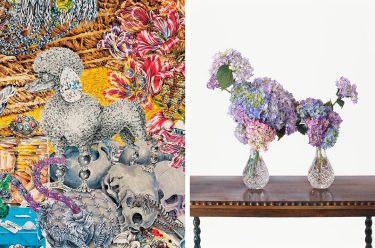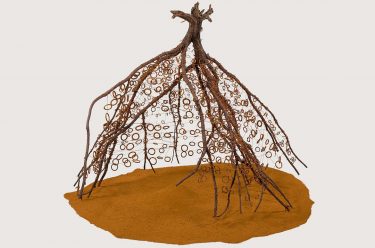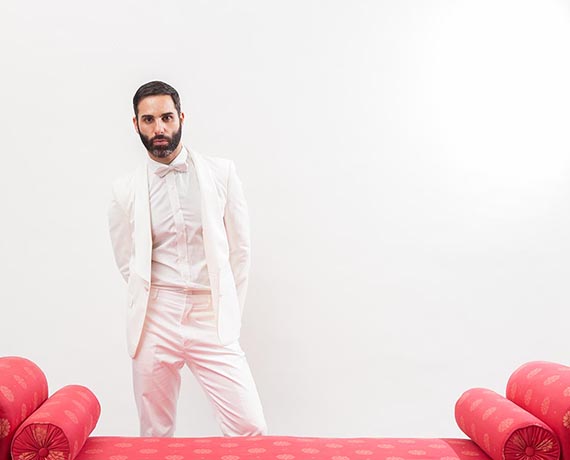
Brisbane-based painter, sculptor and video artist Michael Zavros uses perfection as the overarching theme in his work, evident in his faultless renderings of images from fashion magazines, and vistas of the most sumptuous palaces of Europe. The artist talked to Peter McKay.
Peter McKay | The ‘Artist’s Choice’ exhibition series invites contemporary artists to work with the Collection to assemble a display that sits outside the conventions of ‘professional’ curating. Your approach here has been very distinctive, and relates to your own painting Unicorn in the anticamera 2008, held in the Collection. Could you describe your idea for the show and the relationship between your practice as an artist and this curatorial project?
Michael Zavros | Really, I didn’t want to step out of my role as artist and become a ‘curator’ by making a themed display. I was interested in shifting the experience of an artwork from something on a white wall shown alongside ‘like’ things. I approached the exhibition as though it were an art work, like the three-dimensional evocation of one of my own paintings. I wanted to create a new context for works from the Collection, and offer the objects new life and meaning, by shifting them from a museum to a domestic space. Of course, on the surface, it could be seen as simply Zavros on Zavros. But I took the project very seriously.
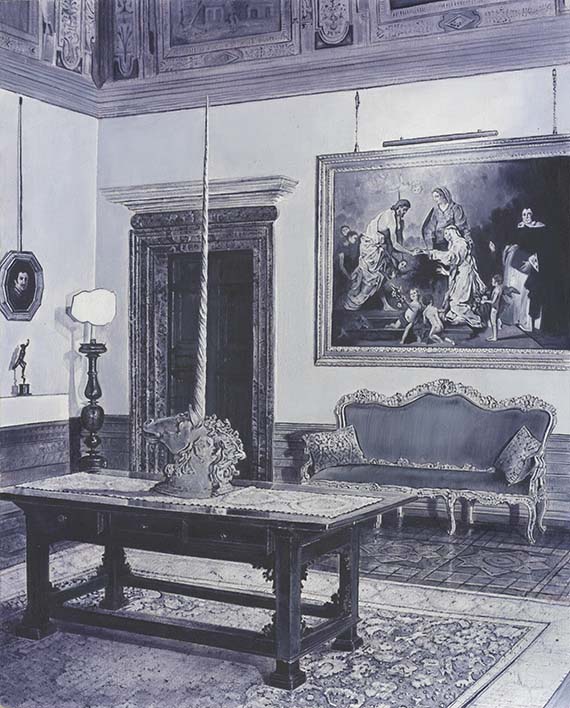
PMcK | This project, and the publication that will accompany it, was guided by the sensibility of home interior magazines. Could you talk through the process?
MZ | In 1956, British Pop artist Richard Hamilton asked, ‘What is it that makes today’s homes so different, so appealing?’ House and home magazines are effectively democratic public exhibition spaces. Everyone can look and admire and consider — and of course have an opinion.
I certainly mimicked an interior-decorating aesthetic, where the space created becomes a singular composition and the art and objects are treated as formal elements.
I am interested in the manner in which art becomes a kind of decorative device, how the same rollcall of collectable artists appears in these homes across Australia or across the world; how their works are displayed alongside furniture and objects — like trophies of wealth but also as measures of intellectual clout or cultural sophistication. These homes are themselves carefully curated — often with the assistance of interior designers and an art consultant.
I also wanted the publication to reflect this fiction and present the Collection as if in a photographic feature. You could say it is an art work in its own right.
PMcK | What is it about the lifestyle of the ‘beautiful people’, or ‘the rich and famous’ that resonates with you as an artist?
MZ | I think I just don’t ‘resist’ it the way artists and arts workers have tended to. What’s not to like about beautiful people or beautiful things? I think beauty is power. It’s as ancient as the Greeks. And I’m Greek. It’s not something Andy Warhol dreamed up or some evil formula concocted in a fashion or cosmetic house.
PMcK | There is a long-running discussion about public and private wealth in this country. What are the most interesting ideas about presenting state-owned public wealth in the guise of an affluent individual’s personal treasure for you?
MZ | We live in philosophically challenging times. I have just returned from Europe — 50 per cent of people in Spain under 30 are unemployed, while at the same time, Rich Kids of Instagram, one of the most curiously successful social media phenomena, enjoys a staggering following. How do these two things co-exist?
As an artist I am often challenged to justify my attraction to beautiful things or luxury items. There is always the assumption that I must be being critical or post-capitalist. The interesting thing, of course, is that very often, significant parts of a collection, including this one, have been gifted by private individuals. Public institutions rely on the philanthropy of private individuals so I am not sure that one can ever draw a line between private and public, or make a distinction. And of course we also tend to appraise differently the same work in the context of a private, as compared to a public, collection.
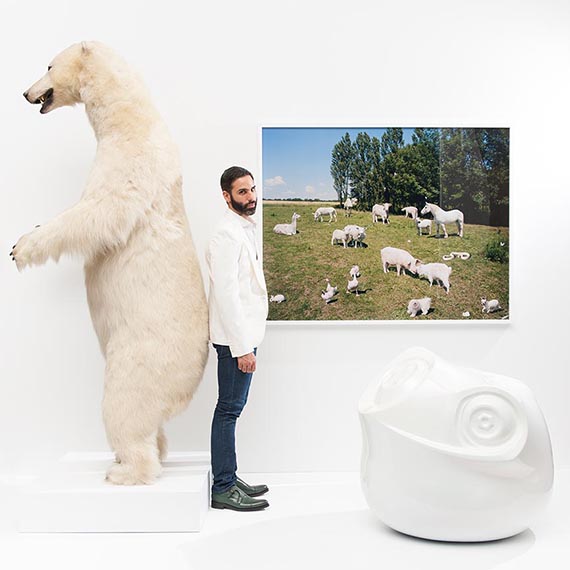
PMcK | Working with the Queensland Museum on this project and the works that will be borrowed for ‘Artist’s Choice’, has been a great insight into their scientific mission. What has been your interest in their collection? What do taxidermied animals represent to you?
MZ | Of course in the context of the exhibition they reflect my own painting practice, which has offered a meditation on art as a contemporary trophy, alongside the taxidermy in the tableaux I paint. More than this, I think taxidermy perfectly articulates the decadence attached to decorating. More than money has been spent on such a trophy — a life has been spent.
I have been collecting taxidermy for many years. For me it functions as a memento mori, and I wanted these beautiful creatures to be seen in this particular context. I find it very beautiful — melancholy and contemplative — and I do think it is a form of artisanship. It’s sad to think of these creatures languishing in storage, and so I wanted them to be seen. I am grateful that the Museum has been so gracious. I was interested to learn that some items are acquired via confiscation by the Australian Customs Service, and that the Museum is generally unlikely to display such pieces.
PMcK | You have been interested in the fiction created by presenting the selected works as a private collection. Have you had a particular collector in mind or did this character and their life story manifest in the moment of selecting?
MZ | The collector evolved as his collection did, although I did imagine a particular kind of individual. On some level, of course, he’s me. I made these choices and my only prerequisite in selecting work was — do I like this?
Mostly I imagined a man of means and intellect for whom art is a pleasure and a folly. The exhibition is conceived as a series of rooms within a home, an apartment in some great city, for example, replete with good furniture, soft furnishings, ceramics and objects and taxidermy. But the fact that this collection contains so much Australian content means it’s likely that the collector is also Australian.
I hope that each visitor will bring with them their own conception of the fictional character that inhabits this space, and this is part of the appeal.
‘A Private Collection — Artist’s Choice: Michael Zavros‘ opens at the Queensland Art Gallery (QAG) this Saturday 23 March. Join Michael Zavros in conversation with Peter McKay at 3pm in the Lecture Theatre. Free entry.
An exhibition publication will be available for purchase from the QAGOMA store and online. Pre-order now to receive a SIGNED copy of A Private Collection — Artist’s Choice: Michael Zavros. Publications will be sent late-April 2013.
